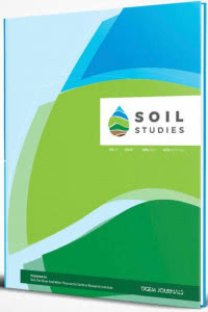Soil erosion and conservation in two geomorphic and recreational environments
Sands, erosion, recreation pathways, conservation.
Soil erosion and conservation in two geomorphic and recreational environments
___
Capararo, G., Mitchell, P., 1995. Fantastic plastic – geotextiles stabilise a walking track. Aust. J. Soil Water Conserv. 8, 21-25.Ciccarelli, D., 2014. Mediterranean coastal sand dune vegetation: influence of natural and anthropogenic factors. Environ. Manage. 54, 194-204.
Cole, D.N., 1986. Recreational impacts on backcountry campsites in Grand-Canyon-National-Park, Arizona, USA. Environ. Manage. 10 (5), 651-659.
Cole, D.N., Spildie, D.R., 1998. Hiker, horse, and llama trampling effects on native vegetation in Montana, USA. J. Environ. Manage. 53, 61-71.
De Luca, E., Novelli, C., Barbato, F., Menegoni, P., Iannetta, M., Nascetti, G., 2011. Coastal dune systems and disturbance factors: monitoring and analysis in central Italy. Environ. Monit. Assess. 183, 437-450.
Department of Agriculture and Department of the Environment, 2012. Maroubra Beach dunes on the mend. http://www.nrm.gov.au/funding/approved/pre- 2008/nsw/sydm/2006-03.html Accessed 24 January 2014
Dragovich, D., Bajpai, S., 2012. Visitor attitudes and erosional impacts on the Coast Walk, Royal National Park. Proc. Linnean Soc. NSW 134, B113-B118.
Gager, P., Conacher, A., 2001. Erosion of access tracks in Kalamunda National Park, Western Australia: causes and management implications. Aust. Geogr. 32, 343-357.
Kutiel, P., Eden, E., Zhevelev, Y., 2000. Effect of experimental trampling and off-road motorcycle traffic on soil and vegetation of stabilized coastal dunes, Israel. Environ. Conserv. 27 (1), 14-23.
Monsef, H.A., Abahussain, A., 2013. The impact of camping activities on soil degradation in Kuwait. J. Environ. Inform. 22 (2), 102-111.
Morgan, R.P.C., Duzant, J.H., 2008. Modified MMF (Morgan-Morgan-Finney) model for evaluating effects of crops and vegetation cover on soil erosion. Earth Surf. Process. Landforms 32, 90-106.
Newsome, D., Milewski, A., Phillips, N., Annear, R., 2002. Effects of horse riding on National Parks and other natural ecosystems in Australia: implications for management. J. Ecotourism 1, 52-74.
Olive, N.D., Marion, J.L., 2009. The influence of use- related, environmental, and managerial factors on soil loss from recreational trails. J. Environ. Manag. 90, 1483-1493.
Phillips, N., Newsome, D., 2002. Understanding the impacts of recreation in Australian protected areas: Quantifying damage caused by horse riding in D’Entrecasteaux National Park, Western Australia. Pacific Conserv. Biol. 7 (4), 256-273.
Randall, M., Newsome, D., 2008. Assessment, evaluation and a comparison of planned and unplanned walk trails in coastal south-western Australia. Conserv. Sci. W. Aust. 7 (1), 19-34.
Randall, M., Newsome, D., 2009. Changes in the soil micro-topography of two coastal hiking trails in south-western Australia. Conserv. Sci. W. Aust. 7 (2), 279-299.
Randwick City Council, 1996. Maroubra Beach: Plan of Management overview. Prepared for Randwick City Council by Hassell Pty. Ltd. 37p.
Wilson, J.P., Seney, J.P., 1994. Erosional impact of hikers, horses, motorcycles, and off-road bicycles on mountain trails of Montana. Mountain Res. Develop. 14, 77-88.
Wimpey, J., Marion, J.L., 2011. A spatial exploration of informal trail networks within Great Falls Park, VA. J. Environ. Manage. 92, 1012-1022.
Zierholz, C., Hairsine, P., Booker, F.,1995. Run-off and soil erosion in bushland following the Sydney bushfires. Aust. J. Soil Water Conserv. 8, 28-37.
- ISSN: 2146-7072
- Yayın Aralığı: 2
- Yayıncı: Toprak Gübre ve Su Kaynakları Merkez Araştırma Enstitüsü
Ali Şenlikci, Mustafa Doğu, Emel Eren, Ebru Çetinkaya, Sevinç Karadağ
Abdelkader DOUAOUİ, İbrahim YAHİAOUİ
The quality of water used for irrigation of agricultural soil in the basin of Kolubara river
Radmila Pivic, Zoran Dinic, Dragana Josic, Aleksandra Stanojkovic Sebic
Soil erosion and conservation in two geomorphic and recreational environments
Cengiz Kaya, Osman Sönmez, Muhammed Ashraf, Tahir Polat, Levent Tuna, Salih Aydemir
Jacek Antonkiewicz, Robert Pelka, Agnieszka Kowalewska
İmre VAGO, Marianna SİPOS, Laszlo TOLNER, İmre CZİNKOTA, Gergely SZİLAGYİ, İbrahim ISSA, Janos KATAİ
Soil microbial biomass and gas-production activity (CO2) in Chernozems of different land use
Kristina Ivashchenko, Nadezhda Ananyeva, Vyacheslav Vasenev, O. Ryzhkov, V. Kudeyarov, R. Valentini
Study of classification and estimation models for soil loss disturbed by engineering construction
